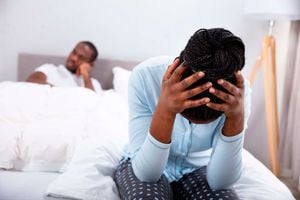Doc, I have no sperm. What now?

You may be having azoospermia, which means that you do not have any sperms in the ejaculate or the sperms are too few to be measured.
What you need to know:
- You may be having azoospermia, which means that you do not have any sperms in the ejaculate or the sperms are too few to be measured.
- For this diagnosis to be made, you need to have two tests done for semen analysis at a reliable laboratory. About one per cent of males suffer from azoospermia. Some types of azoospermia are reversible, while others are not.
Dear Dr Flo,
My wife and I have been trying unsuccessfully to get a baby for the past seven years. I went for a test to check on my semen a few weeks ago and the results show that I have no sperm. Can this be cured? I haven’t told my wife yet.
Dear reader,
You may be having azoospermia, which means that you do not have any sperms in the ejaculate or the sperms are too few to be measured. For this diagnosis to be made, you need to have two tests done for semen analysis at a reliable laboratory. About one per cent of males suffer from azoospermia. Some types of azoospermia are reversible, while others are not.
The azoospermia may either be obstructive or non-obstructive. With obstructive azoospermia, which affects about 40 per cent of those with azoospermia, sperms are made normally in the testicles, but due to blockage along the tubes, they do not get out during ejaculation. The obstruction may be due to abnormalities in formation of any of the reproductive tubes, or because of abnormal growths along the tubes, or due to scarring as a result of infections, instrumentation or surgery. Vasectomy done on both sides (bilateral vasectomy) also leads to obstructive azoospermia. For some people, depending on where the blockage is, there may be retrograde ejaculation, where the semen goes backwards into the bladder after ejaculation. With obstructive azoospermia where sperm production is normal, treatment may include surgical repair of the blockage or use of assisted reproductive techniques
With non-obstructive azoospermia, there is either no sperm being produced by the testicles, or the sperm production is reduced, or the sperms produced are defective. This type affects about 60 per cent of those with azoospermia. This may be as a result of testicular abnormalities or problems with the hormones that control sperm production, either at testicular level, or at the brain level (dysfunction of the hypothalamus or of the pituitary gland). It may also be as a result of genetic conditions like Klinefelter syndrome, deletion of the Y-chromosome among others. It may also occur in people with undescended testes, or following injury to the testicles, or testicular torsion (twisting of the testicles that cuts off blood supply); or in persons with varicoceles, which are swollen blood vessels within the testicles. Other possible causes of non-obstructive azoospermia are testicular cancer, chemotherapy or radiotherapy treatments, heavy metal poisoning, use of anabolic steroids and testosterone supplementation treatment. Following a mumps infection or other infections that affect the testicles, azoospermia may develop.
It is advisable for you to be reviewed by a fertility specialist or a urologist to identify the exact cause of the azoospermia. The tests done may include a repeat semen analysis, hormone levels, ultrasound scans, testicular biopsy and vasography (x-ray examination of the vas deferens to check for blockage). For treatable causes, then the treatment will be provided. Assisted reproductive techniques may be used to retrieve and utilise the healthy sperms available to achieve a pregnancy.
How do I get rid of stretch marks?
Mutiso
Dear David,
Stretch marks are narrow lines on the skin that form when the skin gets over-extended, or when it shrinks and the inner layer of the skin is damaged, leading to inflammation and scarring. The over-extension (or shrinkage) may happen when there is rapid weight gain, for example during the growth spurts in puberty, or during pregnancy, weight training or any other form of fast weight gain or loss. There’s a higher risk of developing stretch marks during seasons of fluctuating hormones, or if there’s long term use of steroids, or due to genetics, or due to diseases like cushing’s syndrome or marfan’s syndrome.
More commonly, stretch marks affect the softer parts of the body like the upper arms, the breasts, the abdomen, the thighs, and the buttocks. Stretch marks do not look alike: they vary based on how long they have been present, type of skin affected and what caused them. They tend to be more distinct when they first appear then fade with time, sometimes having an indentation along the streak/line.
Stretch marks do not require treatment and usually fade with time. However, due to the impact on appearance, many people desire to get rid of stretch marks. Occasionally, some people may experience itching or pain at the stretch mark, especially when they are newly formed.
There is no proven method to completely eliminate stretch marks. Some suggested treatments to make stretch marks less noticeable are tretinoin cream and creams with hyaluronic acid. These work better if applied on early stretch marks and are massaged into the skin. Other procedures to make stretch marks less visible include chemical peels, ultrasound treatment, micro derma-abrasion, radio-frequency and laser treatments.
Dr Flo,
I am 61 years old and I have gone through menopause. My husband is still interested in sex, yet it has become uncomfortable for me in recent years. I feel pain during intercourse and sometimes I feel itchy but there’s no discharge.
Please help.
Dear reader,
Most likely you are experiencing atrophic vaginitis as a result of reduced oestrogen levels in the body after menopause. The lower oestrogen levels lead to dryness, thinning and inflammation of the vaginal walls. The vagina may also shorten and tighten. This may lead to you experiencing reduced lubrication, itching, a burning sensation, pain and/or bleeding during intercourse or a burning sensation. This phenomenon may also affect the urinary system, causing urgency when passing urine, discomfort when passing urine, leaking of urine when pressed and frequent urinary tract infections.
It is advisable for you to be reviewed and examined by a gynaecologist. Some tests that may be requested are urine analysis and a pap smear. Other tests may be requested if necessary.
Though atrophic vaginitis cannot be cured, the symptoms can be managed by using vaginal oestrogen creams, or ring or tablet. Occasionally, the gynaecologist may prescribe hormone replacement therapy to manage menopause symptoms. Discomfort during intercourse can also be prevented by using vaginal moisturisers or a water-based personal lubricant.




